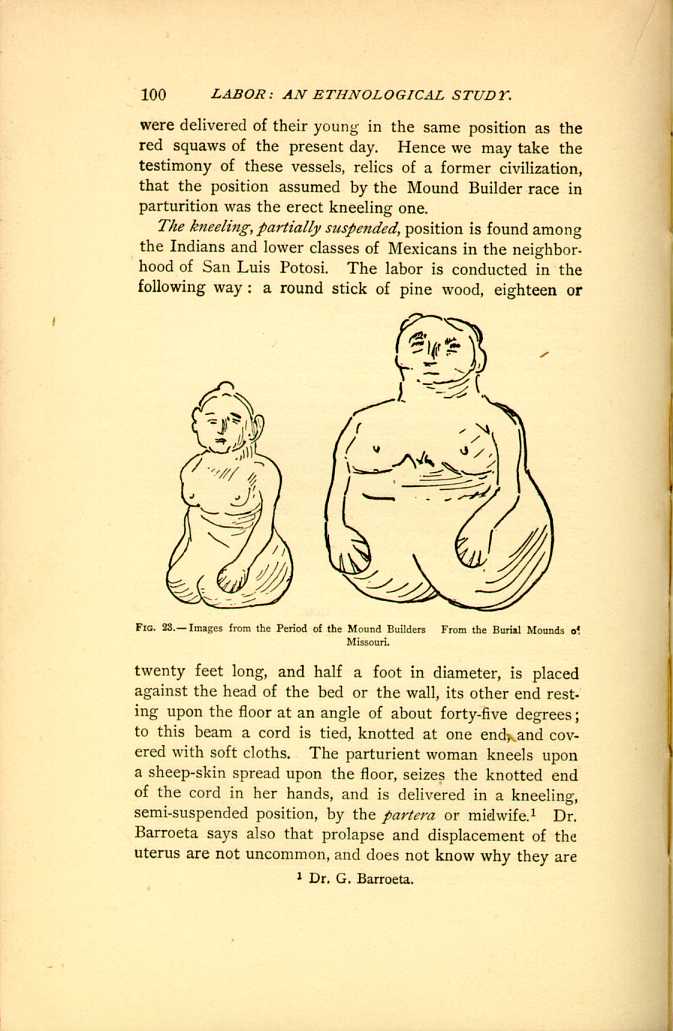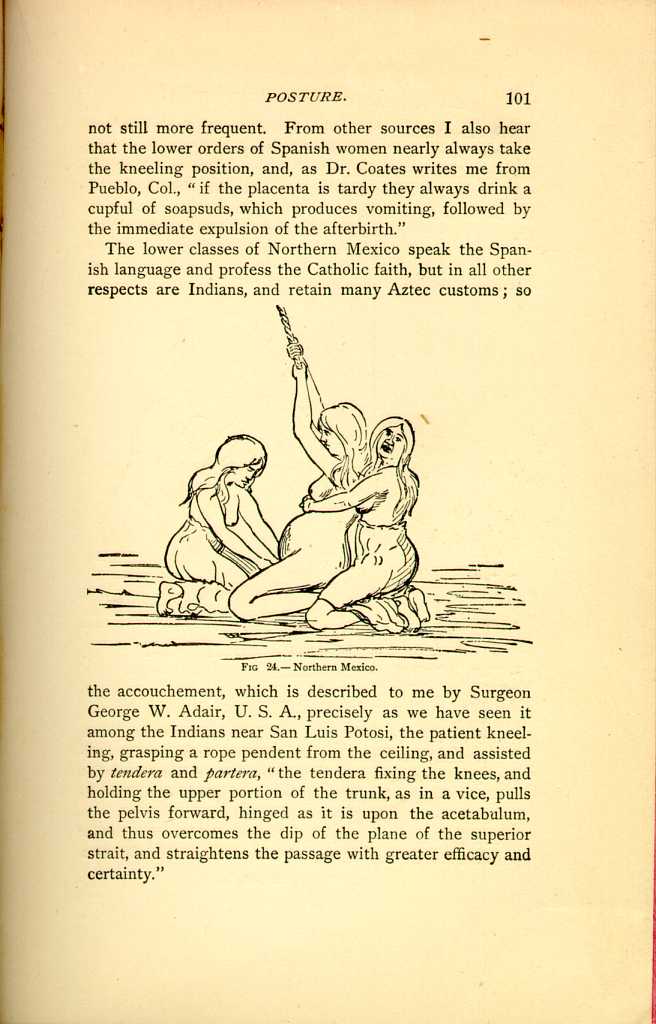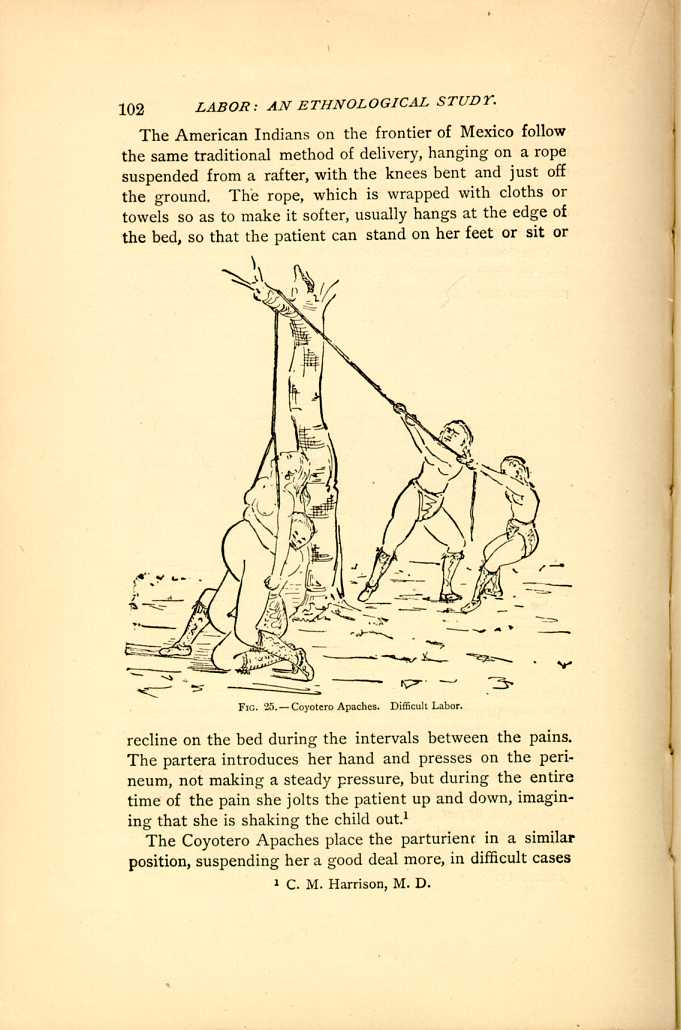| CHAPTER II.
POSTURE IN LABOR. Labor Among Primitive Peoples | ||
(c.) Kneeling, with the body erect, inclined backward, or partially suspended.
This, like other of those apparently peculiar positions which are fast yielding to the westward march of civilization and scientific medicine, was at one time not unusual in our States, and I will cite the early experience of Dr. Reamy in Ohio as characteristic of the practice thirty years ago; he says: "I have found in my practice ten or twelve different women, who had frequently borne children, before, who insisted, with a perseverance and determination that I dared not resist, in being out upon the floor, down upon their knees, leaning backward so that the buttocks almost touched the heels. The husband knelt behind the wife, with his arms around her, his broad strong hands acting as a pad for the abdomen, and making pressure during pains—à la Crédé—her shoulders resting against the man's chest. These women insisted that this was the only position in which they could be comfortably and successfully delivered.'' The same position, practically, is found among the Papagos. Among these Indians, "the position of the squaw, from the time the labor pains commence until the expulsion of the fetus and placenta, is a kneeling one, with the knees sufficiently spread to furnish comfortable lateral support to the body, which is erect. In the interval between the pains she is allowed to move about according to her inclination. In ordinary labors two women assist her. One of them places herself in a kneeling position behind the parturient woman, and with one knee pressing firmly in the lumbar region, she grasps with both hands the body of the patient immediately under the ribs in front. The other assistant places herself in a kneeling position in front of the woman, and with the palms of both hands rubs the abdominal wall down from the spine of the ilium to the pubes. It is interesting to note that they seem to appreciate the necessity and advisability of time and patience with primiparæ, as they do not resort to the same degree of pressure and friction which they employ in assisting multiparæ.[76]
The Yuma Indians vary this position somewhat.[77] The parturient woman is assisted by two others of long experience in the business. One of these kneels behind her, supporting her body in nearly an upright position, her arms passing under those of the patient and pressing or smoothing down the abdomen. The other assistant squats in front, between the feet of the patient, with her ankles crossed, and her shins pressed against those of the parturient woman, whilst she holds her by the hands or wrists. The posture of the patient is, therefore, with the shoulders high, the legs and thighs strongly flexed and abducted, which position is retained until the expulsion of the placenta. No bandage is used.
The Upper Klamath and nearly related Modocs of Oregon are usually delivered in a small lodge some distance away from the other houses. The parturient also assumes a kneeling position, supported by one old squaw, whilst another keeps kneading and rubbing her abdomen. Sometimes she varies her posture by sitting and pressing her feet against some support, while she bears down. If labor is tedious, they often sit over warm stones moistened with water, or, in other words, take a steam bath to relax the system. They also steam themselves occasionally for several days after the birth of the child.[78]
Precisely this same position is found among many of the Mongolians, especially the Tartars, if we may accept the authority of Hureau de Villeneuve.[79] The parturient moves about during the early pains, sometimes standing with her hands above her head, but as soon as the bearing-down pains begin she assumes the kneeling position last described, almost erect, supporting her body upon the hands, which rest upon the separated knees or thighs; the assistant behind supports her by seizing her under the arms, whilst the midwife rests upon one knee in front of the patient.
My attention once called to the subject, I examined my own collection, and found in it two images representing a woman in the erect kneeling posture, the knees somewhat separated, the hands resting upon the knees or thighs in precisely the same position as that assumed by the Mongolians, and probably the Yumas. It is not unlikely that these figures represent parturient women, and it is highly probable that the mythical Mound Builders, be they predecessors of our Indians, or older tribes of the same stock,
The kneeling, partially suspended, position is found among
the Indians and lower classes of Mexicans in the neighborhood
of San Luis Potosi. The labor is conducted in the
following way: a round stick of pine wood, eighteen or

Fig. 23.—Images from the Period of the Mound Builders
From the Burial Mounds of
Missouri.
[Description: Two female figures in erect kneeling posture. Black and white
illustration.]
The lower classes of Northern Mexico speak the Spanish
language and profess the Catholic faith, but in all other
respects are Indians, and retain many Aztec customs; so

FIG 24.—Northern Mexico.
[Description: Pregnant woman kneels, holding onto a rope suspended overhead.
One woman kneels behind her, her hands clapsed above the abdomen, while
another woman kneels before her to assist delivery]
The American Indians on the frontier of Mexico follow
the same traditional method of delivery, hanging on a rope
suspended from a rafter, with the knees bent and just off
the ground. The rope, which is wrapped with cloths or
towels so as to make it softer, usually hangs at the edge of
the bed, so that the patient can stand on her feet or sit or

FIG. 25.—Coyotero Apaches. Difficult Labor.
[Description: Pregnant woman is supported by a loop of rope which has been
thrown over a tree branch in a pulley arrangement. Two assistants hold
the other end of the rope, while a third assistant hangs upon the
pregnant woman, placing pressure upon her abdomen.]
The Coyotero Apaches place the parturient in a similar position, suspending her a good deal more, in difficult cases
The Santee Indians are almost invariably delivered in a kneeling posture on the floor, with a bench or chair in front of them upon which they rest their arms, while sometimes they have a rope attached above by which they partially suspend themselves, just as the Mexican Indians and half-breeds do.[84]
| CHAPTER II.
POSTURE IN LABOR. Labor Among Primitive Peoples | ||